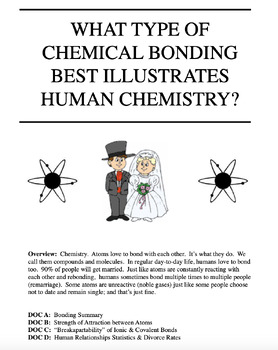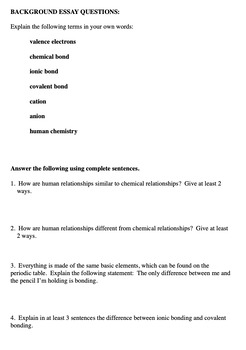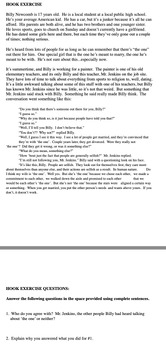Bonding Mini-Q FUN CER Connecting Human Chemistry and Science
Dan Moes
3 Followers
Grade Levels
9th - 12th
Subjects
Resource Type
Standards
NGSSHS-PS1-1
NGSSHS-ESS3-1
NGSSHS-PS1-2
Formats Included
- PDF
Pages
15 pages
Dan Moes
3 Followers
Description
This is a fun way to connect "Human Chemistry" with Chemical Bonding in your Chemistry class. I used this assignment when I taught Chemistry as a way for students to show what they understood about bonding. Students will construct a CER about how Human Chemistry is similar to Chemical Bonding.
This assignment is formatted like a DBQ (document based question) or a Mini-Q.
Total Pages
15 pages
Answer Key
N/A
Teaching Duration
2 days
Report this resource to TPT
Reported resources will be reviewed by our team. Report this resource to let us know if this resource violates TPT’s content guidelines.
Standards
to see state-specific standards (only available in the US).
NGSSHS-PS1-1
Use the periodic table as a model to predict the relative properties of elements based on the patterns of electrons in the outermost energy level of atoms. Examples of properties that could be predicted from patterns could include reactivity of metals, types of bonds formed, numbers of bonds formed, and reactions with oxygen. Assessment is limited to main group elements. Assessment does not include quantitative understanding of ionization energy beyond relative trends.
NGSSHS-ESS3-1
Construct an explanation based on evidence for how the availability of natural resources, occurrence of natural hazards, and changes in climate have influenced human activity. Examples of key natural resources include access to fresh water (such as rivers, lakes, and groundwater), regions of fertile soils such as river deltas, and high concentrations of minerals and fossil fuels. Examples of natural hazards can be from interior processes (such as volcanic eruptions and earthquakes), surface processes (such as tsunamis, mass wasting and soil erosion), and severe weather (such as hurricanes, floods, and droughts). Examples of the results of changes in climate that can affect populations or drive mass migrations include changes to sea level, regional patterns of temperature and precipitation, and the types of crops and livestock that can be raised.
NGSSHS-PS1-2
Construct and revise an explanation for the outcome of a simple chemical reaction based on the outermost electron states of atoms, trends in the periodic table, and knowledge of the patterns of chemical properties. Examples of chemical reactions could include the reaction of sodium and chlorine, of carbon and oxygen, or of carbon and hydrogen. Assessment is limited to chemical reactions involving main group elements and combustion reactions.





